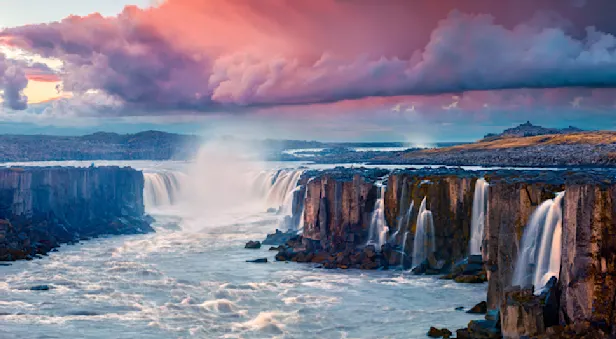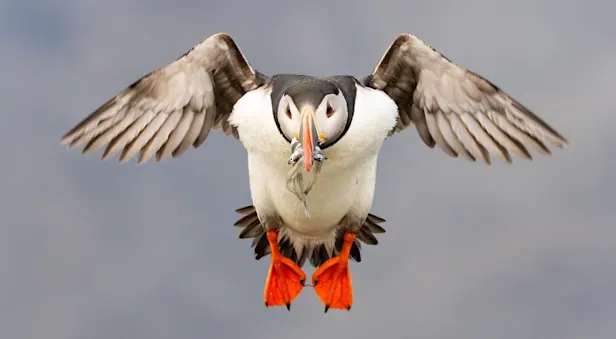Itinerary
Led by naturalist Expedition Leaders who are expert photographers and instructors, our East Greenland Photo Expedition offers a rare chance to capture images of one of Earth's most remote and stunning wild places from our remote base camp. Capture eye-level images of icebergs and Arctic marine life on Zodiac and sea kayaking excursions in Sermilik Fjord. Since our photo departures occur later in the season, you may even get a chance to photograph the northern lights.
Arrive at Keflavik International Airport where you're met on arrival and transferred to our hotel in Reykjavik, the capital of Iceland, less than an hour's drive. If you arrive very early, you may store your bags at our conveniently located hotel while you explore this compact, photogenic city on your own. This evening, gather for a welcome dinner and presentation with our Expedition Leaders.
Our adventure begins with an immersion in Iceland’s dramatic volcanic and geothermal features. First, we have a private tour of the Raufarholshellir Lava Tunnel to witness the inner workings of an ancient volcanic eruption that happened 5,200 years ago. Inside the lava tube—one of the longest in Iceland at 4,500 feet—we learn the origins of the vibrant colors and intriguing rock formations. Then we head down the Reykjanes Peninsula to photograph the features of Seltun, one of Iceland’s most important high-temperature geothermal areas. Lying on the fissure zone of the Mid-Atlantic Ridge separating the Eurasian and North American tectonic plates, this dynamic landscape is pocked with boiling mudpots and hissing fumaroles belching steam. As we follow the boardwalk through this animated landscape where mineral deposits have created colorful sediments, the pungent odor of sulphur hangs in the air. The Reykjanes Peninsula is one of Iceland’s most active volcanic areas, with seven separate eruptions occurring in 2024 alone.
Continue to Keflavik, returning to Iceland's international airport where we board our late afternoon flight to Kulusuk, Greenland. As we approach, get a preview of the magnificent scenery to come, with icebergs drifting below and perhaps even a chance to spot a whale from the air, if you've got a window seat. From Kulusuk, make a scenic transfer by helicopter or boat to Ammassalik Island, landing in Tasiilaq, the small administrative center of East Greenland. Tasiilaq's collection of charming wooden houses painted in bright primary colors hugs King Oscar’s Harbor, surrounded by pointed peaks iced with glaciers. The town of 2,000 is a hub for outdoor adventure, from hiking and kayaking in summer to dog sledding and glacier skiing in winter. Most of East Greenland is uninhabited, however, except for a handful of small subsistence hunting communities. Greenland's east coast is often called "the back side" by those on the west, where most of the population, its capital and institutions are located. East Greenland's people had no contact with the outside world till the beginning of the 20th century, and that isolation has fostered a distinct and resilient culture. Our introduction to Greenland begins here where Arctic wilderness and traditional lifestyles meet. Once we check in to our hotel, we gather for dinner, surveying the 180-degree view of the town below and mountains beyond.
Though interior Greenland is covered by a massive ice cap, a few habitable areas exist around the bays and coastal islands, and the region we visit enjoys a surprisingly mild and dry summer climate. Set out this morning with our Expedition Leader to explore the photogenic area around Tasiilaq on foot, hiking into the Valley of Flowers above the scenic bay abutting town. Here the ice-clad gneiss and granite peaks provide a striking backdrop for waterfalls and small lakes fringed by northern wildflowers in season. We spend the afternoon in town learning about the region's history and contemporary daily life. The small Ammassalik Museum, a highlight, showcases Greenlandic Inuit culture and traditions. Its collection features East Greenlandic masks, kayaks, sleds, tools, beadwork, old and new tupilak figures, and works by local artists. Later this afternoon, we'll also hear firsthand experiences from a local resident who shares personal perspectives on daily life and subsistence in this remote Arctic realm.
Depart by boat for our exclusive wilderness Base Camp, located on the east side of Sermilik Fjord. Our destination is near the tiny hamlet of Tinit, which we'll visit during our stay. The village is one of the most picturesque outposts in East Greenland, offering the chance to shoot the panorama of Sermilik Fjord littered with huge icebergs. Behind the town, glacier-clad peaks rise over a mile high, jutting up like sharp black teeth through the ice. Tinit is home to fewer than a hundred hardy people who live a subsistence lifestyle, fishing and hunting amid constantly shifting ice.
Keep your camera close as we search for whales as we travel, as they are often seen in these waters when ice conditions permit. The area is filled with evidence of ancient habitation, including graves and ruins of old Inuit sod house foundations, and it is an evocative place to learn more about Inuit history and lore. Reaching Base Camp Greenland, we find ourselves in one the most remote places on the planet. After settling in to our private tent cabins, sit down for coffee, tea and lunch in the yurt. We’ll convene for an orientation to our environs, followed by a gear fitting to prepare for our Arctic adventures ahead. An afternoon exploration is likely to include a paddle among the small icebergs and calm waters of our protected bay if weather permits, then we'll gather for dinner and a lecture to acquaint us with the region's remarkable natural history. Through presentations and personal visits during our stay, we also learn about Greenland’s cultural heritage and aspects of modern life. Traditional Inuit identity remains dominant in East Greenland, and we share an authentic encounter with this enduring culture that still exists in close harmony with nature.
The landscape along Greenland’s isolated and rarely visited east coast is dramatic. Great fjords indent the coastline, penetrating far into sheer-sided mountains capped by the world’s second-largest ice sheet—and Sermilik Fjord is the mightiest of them all. The 60-mile-long "iceberg highway" is primarily fed by the highly active Helheim Glacier, the fastest-flowing tidewater glacier on Greenland's east coast. Our base camp provides a safe and comfortable outpost from which to explore and photograph this vast expanse of wild terrain just below the Arctic Circle. Beyond our location at the mouth of a glacial valley, the wider region is dotted with a few isolated villages where Greenlandic Inuit people have thrived for centuries in this uncompromising Arctic environment. In varied encounters, we learn about their culture and how they are retaining their traditions while adapting to contemporary life in the 21st century.
On Zodiac excursions, navigate among a flotilla of blue icebergs in an array of wild shapes, some as big as buildings, as we seek out seals. Whales are also found seasonally in these waters, when ice conditions permit, and we'll look for fin, minke and humpback whales. Guided sea kayaking is also an option for getting eye-level photos on the frigid waters and bobbing ice. Ashore, we traverse the mountainsides and wander near glaciers that wind down from the Greenland ice sheet. This huge ice mass—second in size only to Antarctica—stretches more than 1,500 miles from north to south, is nearly 2 miles deep at its thickest point, and covers 80 percent of the island. Learn about the crucial role the ice sheet plays in regulating Earth’s climate and see with your own eyes how rapidly it is being affected by a warming climate.
Long hours of summer daylight allow for extensive exploration. Witness the effect of geological forces on naked bedrock, and walk atop patches of tundra. Amid fields of Arctic cotton grass, look for Arctic fox and birdlife including ptarmigan, northern wheatear, and possibly gyrfalcon. Each evening, we retreat to Base Camp for creative meals prepared by our accomplished chef. After dinner, gather for interpretive presentations by our naturalist Expedition Leaders, who share their extensive knowledge of Greenland's geology, glaciology, ecology and human history, as well as their tips for how to best photograph this wild landscape and its inhabitants. And, though the sun gleams late into the evening just below the Arctic Circle, a good night's sleep is in order to refuel for the next day's adventures. Wrapped in profound silence in our isolated cabins, we're sure to get it. On our late-season departures, we may even have a chance to photograph the northern lights, if the aurora is active in the darkening night sky.
Today we make our way back to Kulusuk by helicopter or boat, depending on weather conditions and availability. Survey jagged peaks and huge U-shaped valleys gouged by glaciers as you practice your aerial photography skills, or take parting photos of icebergs and whales as we cruise the frigid water. On arrival in Kulusuk, check in to our hotel surrounded by more of East Greenland's imposing mountains—it's a well-known gathering point for adventurers and scientists heading out to the ice sheet. This afternoon, we'll take an exploratory coastal walk with sweeping views of icebergs and mountains. We then enjoy a private performance of traditional Greenlandic drumming and dancing—an opportunity for cultural photography and videography—before gathering for dinner.
This morning, we board a boat to head out for a half-day glacier walk excursion with exciting photo opportunities. In addition to large chunks of ice calved from glaciers that feed the region's fjords, we may also see tabular icebergs—oceangoing slabs of ice, some of which have been drifting for months, driven down the coast by the strong East Greenland Current. Reaching a small island, we disembark to walk on a glacier, surrounded by spectacular views of fjords and mountain ranges. Atop its rough surface, examine unique formations including deep crevasses and moulins, which are whirlpool-like shafts in the ice. We also explore the interior of an ice cave, capturing mesmerizing images of its surreal shapes and shades of blue. Walking farther, we reach a vantage point for a full view of the glacier’s face, with an opportunity to photograph it in its entirety.
Returning to Kulusuk, it's time to celebrate our extraordinary adventure over a farewell lunch at the hotel. In the afternoon, explore the town on a guided tour before flying back to Iceland's Keflavik International Airport, arriving late this evening. We spend the night at an airport hotel nearby to facilitate easy connections for tomorrow's onward departures.
A transfer is included to Keflavik International Airport to meet departing flights. Please Note: This itinerary is meant as a guideline and can change due to weather and ice conditions.
Given the expeditionary nature of our trip, on some occasions, adverse conditions may require us to deviate from our intended itinerary, in which case we will provide the best available alternative. And we’ll make a great adventure of it!
Pair This Trip with Another Nat Hab Journey

Iceland: Circling the Land of Fire & Ice
An immersive journey into the rugged grandeur of a land sculpted by intense geological forces. Make a full loop around Iceland on the most comprehensive nature adventure this compact country has to offer.

































